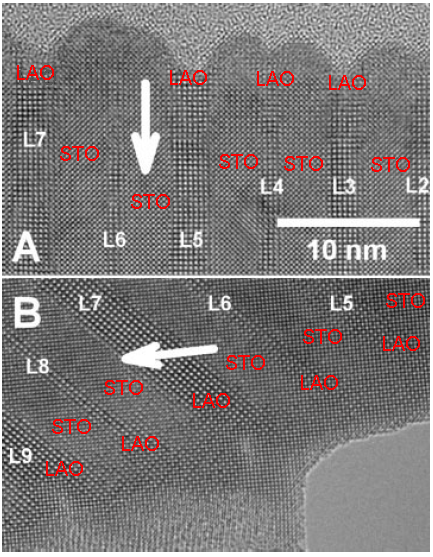=================================================================================

|
Figure 4494. HRTEM images showing that the LAO layers can be destroyed faster than the STO layers in the FIB milling of a thick film (A) and this effect is less significant in the FIB-milling of a thin film (B). Adapted from [1]. |
Researchers have studied the preferential destruction of multilayers in FIB milling. For instance, preferential destruction had been observed in FIB milling of LAO (LaAlO3) and STO (SrTiO3) multilayers [1]. In this system, as shown in the HRTEM images in Figures 4494, when the TEM film is relatively thick (Figure 4494 A) the LAO layers are destroyed faster than the STO layers, while for the thinner LAO layers , L6 and L8 (Figure 4494 B), the preferential destruction of the LAO layers is less. This preferential destruction means that preferential milling, or at least preferential amorphisation occurred during FIB-milling process. It should be mentioned that the preferential destruction of the LAO layers is not compatible with the measured etching rate of pure LAO and STO. In fact, the preferential destruction is related to the difference of stress in crystalline structures of LAO/STO multilayers. In this system, the rombohedral LAO with a pseudo cubic lattice parameter a = 0.379 nm, has to grow on a cubic STO with lattice parameter a = 0.390 nm, the LAO layers was in tension which could explain their faster destruction. However, in the thinner LAO layers, L6 and L8 (Figure 4494 B), the preferential destruction of the LAO layers is less because for the thin LAO layers the built up strain will be less.
[1] Evaluation of Top, Angle, and Side Cleaned FIB Samples for TEM Analysis, Eduardo Montoya, Sara Bals, Marta D. Rossell, Dominique Schryvers, and Gustaaf Van Tendeloo, Microscopy Research and Technique 70:1060–1071 (2007).
|